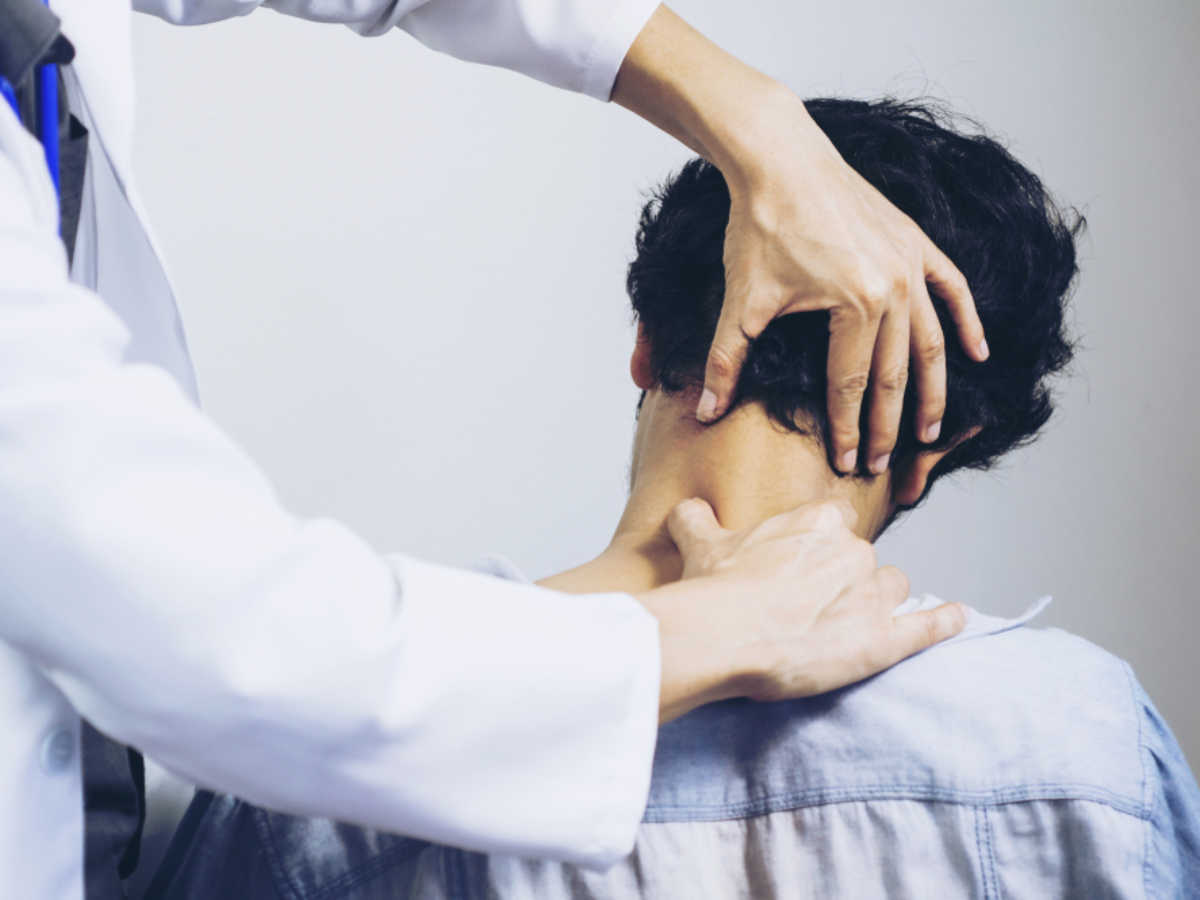SEVERE NECK PAIN
Neck pain is caused when muscles in the neck are strained from poor posture such as leaning over the computer or hunching over the workbench. Neck consists of vertebrae which extend from the skull to the upper torso. A cervical disc is important to absorb shock between the bones.
The bones, ligaments, and muscles of the neck support the head allowing the motion. Abnormalities, inflammation and injury might lead to neck pain or stiffness that many people might experience occasionally. Neck pain is also caused due to poor posture or overuse, by injury from a fall, contact sports, or whiplash.
Neck pain is mostly not a serious condition or indicates serious illness but it might continue for more than a week, is accompanied by other symptoms or severe in nature and seek medical attention immediately.

CAUSE OF NECK PAIN
Neck pain could be caused by multiple reasons like:
- Muscle tension and strain – This could be caused by poor posture, working at a desk for a long duration in a single position, sleeping with the neck in a bad position and a sudden jerk in the neck during exercise. Sometimes, even minor things like reading in bed or gritting the teeth, might also strain neck muscles.
- Injury – Neck is vulnerable to injury such as falls, car accidents, and sports that causes the muscles and ligaments of the neck to move outside of their normal range with force. In some cases, the neck bones (cervical vertebrae) are fractured causing damage to the spinal cord. Neck injury caused due to sudden jerking of the head is known as whiplash.
- Heart Attack – Neck pain is sometimes a symptom for heart attack along with other symptoms.
- Bulging or herniated disc – The spinal disc contains a gel-like center that can bulge or rupture through a weak area in the wall as well as compressed nerves.
- Pinched nerve – Compression of a spinal nerve leaving a canal could cause pain that travels down the arm into the hands and even fingers. Pinched nerve pain is different from carpal tunnel syndrome that mainly involves numbness in the affected area.
- Meningitis – This causes inflammation of the thin tissue surrounding the brain and spinal cord. People suffering from meningitis have fever and headache that often occur with a stiff neck. Meningitis could be fatal and is a medical emergency.
- Disease – Neck pain and stiffness is also caused by rheumatoid arthritis, osteoporosis, fibromyalgia, spondylitis, herniated cervical disk and spinal stenosis causing damage to muscles and ligaments of the neck.
Neck pain rarely could be caused due to congenital abnormalities, infections, abscesses, tumors and cancer of the spine.
SYMPTOMS OF NECK PAIN
Neck pain could vary in intensity that ranges from an annoying discomfort to extremely painful, sharp, and limiting condition. The degree of reduction in neck motion might affect the individual’s activity levels in daily activities like the head cannot be turned in one direction without excruciating pain, driving to be avoided until symptoms improve. Other symptoms depending on the underlying medical condition are:
- lump in the neck
- fever with or without headache
- swollen glands
- nausea and vomiting
- trouble swallowing or breathing
- weakness along with numbness or tingling
- pain radiating down the arms or legs
- inability to move the arms or hands
- inability to touch the chin to chest
- bladder or bowel dysfunction

EXERCISE FOR NECK PAIN
Neck pain and stiffness could easily be reduced with exercise along with medication for easing off the pain. Doctors diagnose the underlying medical reason for neck pain or stiffness with tests like blood tests, imaging tests like X-rays, CT scans, MRI scans, electromyography, that allows the doctor to check the health of muscles and the nerves controlling the neck muscles and lumbar puncture (spinal tap).
Neck pain relief program consists of a combination of exercises like stretching and strengthening exercises, aerobic conditioning, and mainly trigger point exercises. In case the neck, chest, and upper back muscles are weakened, tightened, and/or elongated would lead to the shoulders becoming rounded and the head sagging forward. This poor posture puts more stress on the cervical spine’s facet joints and intervertebral discs and the muscles or ligaments.
Neck Stretches
Flexibility and stretching exercises help in expanding or preserving the range of motion and elasticity in affecting cervical (neck) joints that would in turn relieve the stiffness that accompanies pain.
- Forward and Backward Tilt – It is important to be in a comfortable state for the exercise. Head and back should be straight. To feel the maximum stretch move the chin towards the chest as well as hold it for around 15-30 seconds and then move the head back. Repeat the stretch several times a day till the pain and stiffness reduces.
- Side Tilt – The exercise is performed while standing, with the feet hip-width apart and arms towards sides. Then gently tilt the head toward the right shoulder (shoulder should not be raised) and try to touch it with the ear till the stretch is felt. It is important to hold the position for about 5-10 seconds for maximum benefit. For extra stretch, the hand can be placed on the same side of the tilted head on top of the head, and pressing lightly with your fingertips.
- Side Rotation – It can be done both while sitting and standing position. The head and the back should be aligned straightly with slowly turning the head to the right until the stretch is felt in the side of the neck and shoulder. Holding the stretch for 15-30 seconds for maximum benefit is necessary to ease off the pain and stiffness. For quick relief it should be performed 2-3 times a day with both sides.
- Shoulder Roll – This provides best results while standing position. The exercise is performed by raising the shoulders straight up and moving them in a circle going forward and backwards for about 6-10 times.

Neck strengthening
Strengthening exercises would help maintain improved posture that would lessen or eliminate recurrent flare-ups of pain. Neck strengthening exercises should be done frequently to allow muscles time to repair themselves. Strengthening the postural muscles especially the muscles of the neck, shoulders, and back help in improving neck pain and prevent future injuries.
- Head Lifts – This exercise strengthens the neck muscle that is performed by Lie flat on the back with the arms stretched to the sides followed by nodding the head and tuck in the chin. Holding the position and then releasing back to neutral position would help strengthen the muscles.
- Lateral Rise – The exercise is performed by standing feet shoulder-width apart with weight in each hand. While keeping the body still you would have to move the arms outward until level up with the shoulders.
- Anterior Rise – The arms are slowly moved with both weights forward, away from the body with the arms kept straight and moving until the weights are leveled with the shoulders.
Other exercises like rows and seated overhead press also help in strengthening the neck ligaments and muscles.
Aerobic conditioning
Aerobic exercise or cardio exercise is fueled with steady intake of oxygen while keeping heart rate and breathing levels elevated during the workout. These would help increase the blood flow to the muscles and soft tissues of the neck along with the upper back that can help loosen the muscles as well as increase range of motion.
OUTLOOK
Depending on the specific diagnosis as well as level of pain, different treatment methods and exercises are recommended for neck pain. It is critical for patients to seek medical advice for cervical spine condition and evaluate neck pain.
If you or anyone you know is suffering from severe neck pain, our expert providers at Specialty Care Clinics will take care of your health and help you recover.
Call us on (469) 545-9983 to book an appointment with our specialists.
